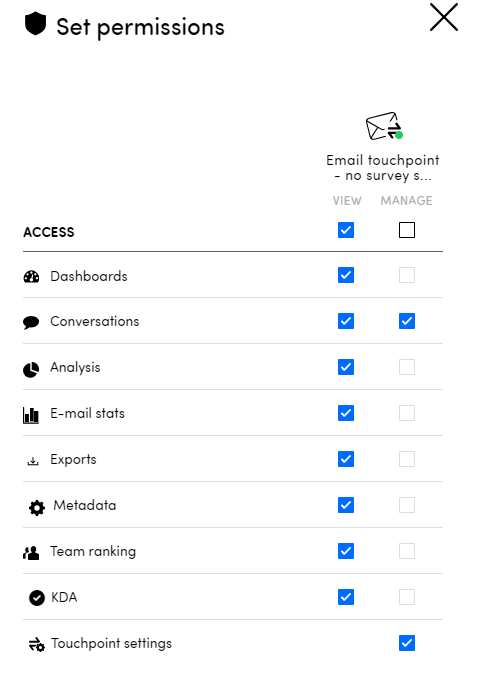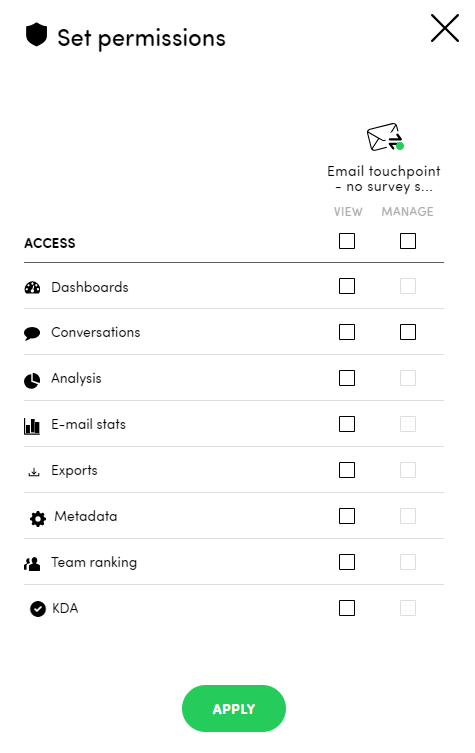Teams - Setting permissions
It is possible that you do not want all users of the platform to view and manage the same things. For example, your regional managers need to see the dashboards to follow-up on the score and the most mentioned topics and your store managers need to follow-up with the customers directly. This is where permissions come in handy.
IN THIS ARTICLE
1. Where to find the permission settings?
Deciding who can do what in the platform is a part of the teams section in the platform. How to get there?
Step 1: Go to Settings via the left navigation menu

Step 2: Go to Teams
Option 1: Click on the Teams tile on the settings overview page.

Option 2: Click on Identity management in the left navigation menu and go to the Teams tab.
Step 3: You can find the view and manage permissions on the right of every team hidden behind
the shield icon.

2. What do the different permissions do?
First of all, it is important to understand the difference between permissions to view and manage the different parts of the platform and the permissions to see certain data (answers).
2a. Data permissions
As you might already know, your collected answers are linked to a certain team unit - which is the lowest level in the team structure - by a metadata key also known as the teams filter. All respondents have a value on this key and the different values are the team units. That way, answers from respondents are linked to the team structure. You can read in this article how to set this all up and make sure your data will be linked to the team structure in the correct way.
To make it more clear which data users will see in the platform, consider the team structure below. "Nice" and "Paris" are team units. This means that answers from respondents are directly linked to "Nice" or "Paris". Next to each team unit, you can see the amount of transactions (= respondents added) and answers (= amount of answers) for this specific unit. As long as this is both 0, teams can be removed from the team structure.
Users that are added to the team level "Nice", will only be able to see the answers that are linked to this unit. These are all the answers from respondents with the value "Nice" on the teams filter. The same applies to users on the "Paris" level. On the contrary, users that are added to the team "France", will see both data for "Nice" and "Paris". Users on the level "Europe", will see all data for France - which consists of answers linked to "Nice" and "Paris", Austria and Belgium - which consists of answers linked to the team units that fall under Austria / Belgium. Users that are added on the top level "Team" will see all answers.

2b. View and manage permissions
The permissions to view and manage the different parts of the platform are linked to a certain team level and can be managed by clicking on the shield next to the team. All team members on the same level will have the same set of permissions. When clicking on the shield, you will see a different set of permissions that can be chosen. Top level team users (= users linked to the highest team) have an extra possible permission, namely managing touchpoint settings, compared to the users on all other levels.
Top level team users

For other user

i. Permissions to view
For several parts of the platform, you can give permissions to our users to view these pages or information.
Dashboards
If you give view rights to our users for the dashboards, they will have access to the dashboard part of the platform. This can even be regulated even further in the team structure, with the dashboard icon next to the permissions icon:

When clicking on this dashboard icon, you can define which dashboards (per touchpoint linked to this team) the different team levels can access. This can come in handy if you for example want to build different dashboards for your regional managers and your store managers.

Conversation
View rights give you permission to see the conversations in the platform. There you can read all individual feedback from your customers. With view rights on the conversations, you can also open the side panel in other parts of the platform (dashboards, analysis, KDA) to read the feedback behind certain ISAAC categories.
IMPORTANT
This permission is necessary in order to the users linked to the team to receive alerts set to responses given to the team
Analysis
When you have permissions to view analysis, you can see the summary results of all your questions that are part of your survey. You will also see the text analysis ISAAC which will tell you what topics your customers are (un)happy about.
E-mail stats
This gives you access to the e-mail stats within the report section where you can find all information about sent emails, how many are delivered, opened etc. This page is only available for email touchpoints.
Exports
Export permissions allow you to make exports in certain parts of the platform. Be aware that exports will only be allowed in combination with other permissions:
- view rights on the e-mail stats: there you can make exports of all invitations, unsubscribe, and not delivered emails.
- view rights on the team ranking: there you can make an export of the team ranking.
- manage rights on conversations: there you can make an export of the raw answer data, including the ISAAC analysis.
- view rights on the key driver analysis: there you can make an export of the table with the details of the calculations.
Please note that it also works the other way around: if you do not have permissions to export, but you do have view access to conversation manager or team ranking, you will not be able to trigger an export there.
Metadata
The view metadata permissions allows you to use the filters in the analysis section, the e-mail stats, the conversation manager and the dashboards. These filters are based on your metadata keys. They contain all the different values your customers have on these keys. Of course, you also need view permissions for analysis, e-mail stats, conversation manager and/ or dashboards to be able to use the filters.
Note
This permission is also necessary to use the general filter option on Dashboards


Team ranking
This gives you access to the team ranking within the reports section. Users only see their own team, every team that falls under their team and and every direct parent.
To make this more clear, imagine this is the team structure:

A user on the level of "Vienna", will see this in the team ranking tab:
- Its own team: Vienna
- The direct parent teams: Austria, Europe and Team

A user on the level of "Austria", will see this in the team ranking tab:
- Its own team: Austria
- The direct parent teams: Europe and Team
- The teams that fall under the assigned team: Salzburg and Vienna

KDA
KDA, or key driver analysis, gives the user access to the prioritize module of the platform. Of course, only the data to which the users have access is included in the key driver analysis. Since this is only calculated when there are at least 100 answers with at least 1 mention, it is possible that no key driver analysis is present for the user.
ii. Permissions to manage
There are two parts of the platform that can be managed by regular users, next to admins:
Conversation
Having the right to manage conversations opens up a lot of options to handle the follow-up with customers after you received feedback from them.
- First of all, users can update the status of a conversation. They can mark if a conversation is to do, in progress or done. It's also very easy to filter out all conversations with a certain status.
- There is a copy functionality where you can copy all the information you need very easily to be able to follow up with a customer in another system.
- Users can add a summary to a conversation to add extra information about the follow-up or other updates.
- They can add tags to the conversations. Also, a filter is available to filter on the different tags that were added by the users.
People who only have view access to the conversations, can also filter on the tags, see the status and summaries, but can not add summaries or tags and update the status themselves. More about the conversation manager can be found here.
Touchpoint settings (only available for top level team users)
Top level team (= highest team) users can be given rights to manage touchpoint settings. That way, they can see the touchpoint settings page and they can add participants to e-mail touchpoints and upload answers in ask anywhere touchpoints. However, they do not have the permission to manipulate the survey.
This permission can be managed per touchpoint that is linked to the team. Be aware that a touchpoint either needs to be in production or inactive before you can add this permission. They will not be able to set up touchpoint themselves and they will not see the touchpoints that are still in draft.
.png)

